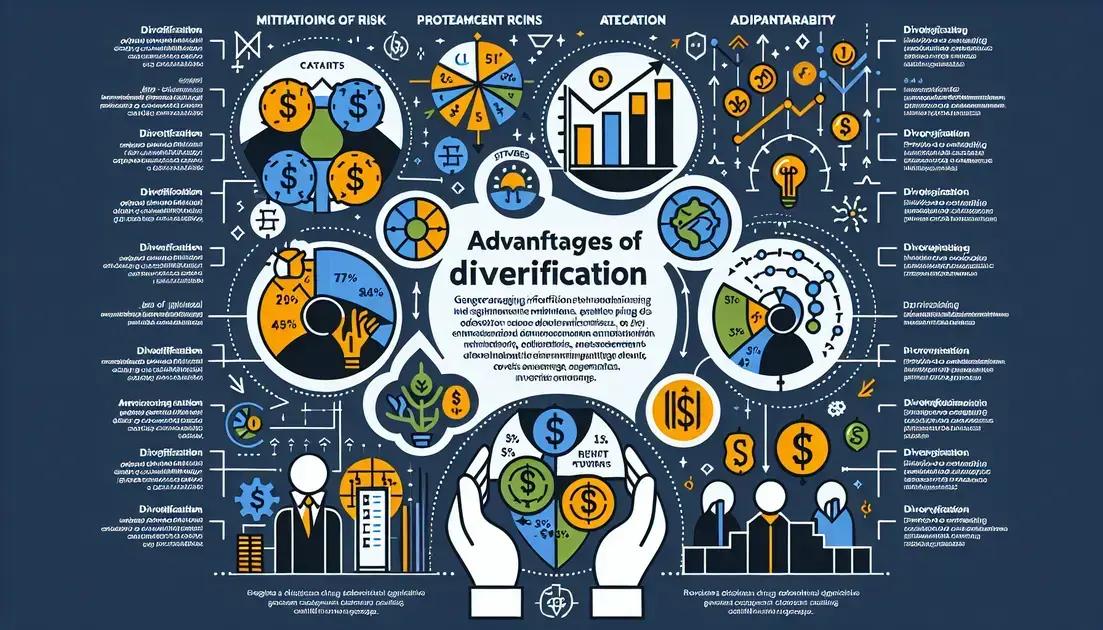Unlocking the Power of Investment Growth
Advertising
In the world of investing, Diversification is a powerful tool that can shield you from market volatility. By spreading your investments across different sectors, you can significantly reduce risk while aiming for steady growth. This article will explore various diversification strategies, outlining how you can enhance your financial portfolio effectively. You’ll discover why having a diversified approach to investing is crucial for long-term success.
Understanding Diversification in Investments
Understanding Diversification is crucial for anyone looking to grow their investments. It means spreading investments across various assets to reduce risk. By not putting all your money in one place, you can protect yourself from market changes.
Why Diversify?
Diversifying helps ensure that if one investment does poorly, others may still do well. For example, if you invest in both stocks and bonds, losses in one area may be balanced by gains in another. This balance can create more stable returns over time.
Types of Diversification
There are many ways to diversify your investments:
- Asset Class Diversification: This involves investing in different asset types, like stocks, bonds, and real estate.
- Geographic Diversification: Investing in different countries can help protect you from local market downturns.
- Sector Diversification: This means investing in different industries, such as technology, healthcare, and consumer goods.
Implementing Your Diversification Strategy
To successfully diversify, assess your risk tolerance and investment goals. Consider how much risk you are willing to take and how long you plan to invest. Regularly reviewing your portfolio is important, as it allows you to adjust your investments based on market changes.
For instance, if technology stocks are performing well, you might want to increase your investment in that area. Conversely, if a sector is underperforming, consider reallocating your funds for better results.
Monitoring Your Diversified Portfolio
Monitoring is key to ensuring your diversification strategy is effective. Keep an eye on how different assets are performing and remain flexible. The markets change, and what works today might not work tomorrow. Adjust your investments as necessary to maintain balance and reach your financial goals.
The Benefits of Diversification Strategies

The Benefits of Diversification Strategies play a crucial role in maximizing investment growth while minimizing risks. By diversifying, you spread your investments across various assets. This approach can help protect your funds during market fluctuations.
Risk Reduction
One of the main benefits of diversification is the reduction of risk. When you invest in different asset classes, a poor performance in one area can be balanced by gains in another. For example, if stocks decline, bonds or real estate might perform better, stabilizing your overall portfolio.
Increased Potential Returns
Diversifying can also enhance your potential returns. By investing in various markets, you may encounter higher growth rates in certain sectors. For instance, if technology stocks are booming, having investments in that area can lead to greater overall returns for your portfolio.
Protection Against Market Volatility
Market volatility can impact investments significantly. A diversified portfolio helps cushion the blow during turbulent times. By having a mix of assets, your portfolio is less likely to suffer from sudden market shifts, providing a more stable investing experience.
Flexibility and Adaptability
With a diversified portfolio, you gain flexibility. You can adjust your investments based on changes in personal goals or market conditions. This adaptability allows you to respond to economic trends while keeping your long-term financial objectives in view.
How to Diversify Your Investment Portfolio
How to Diversify Your Investment Portfolio is a key skill for any investor aiming for growth. Here are some practical steps to get started:
Assess Your Current Investments
Begin by reviewing your existing investments. Identify which assets you own and their performance. This will help you understand your current risk levels and where you might need to improve.
Define Your Investment Goals
Next, set clear investment goals. Are you looking for long-term growth, short-term gains, or income generation? Knowing your goals will guide your choices in diversifying your portfolio effectively.
Incorporate Different Asset Classes
Diversification requires including various asset classes in your portfolio. Consider the following:
- Stocks: Invest in a mix of large-cap, mid-cap, and small-cap stocks from different sectors.
- Bonds: Include government, municipal, and corporate bonds to balance risk and return.
- Real Estate: Explore options like REITs (Real Estate Investment Trusts) for real estate exposure without direct property ownership.
- Commodities: Think about including gold or oil to protect against inflation and market changes.
Regularly Rebalance Your Portfolio
A diversified portfolio needs regular rebalancing. Over time, some investments may grow faster than others, changing your risk profile. Review your portfolio at least once a year and adjust your allocations to maintain your target mix based on your investment goals.
Stay Informed and Adapt
Lastly, keep up with market trends and economic conditions. Being informed allows you to adapt your strategies as needed. If a sector is underperforming, consider shifting your investments to more promising areas to maintain a balanced and fruitful portfolio.
Common Mistakes in Diversification

Common Mistakes in Diversification can lead to poor investment results. Here are some mistakes investors often make:
Over-Diversification
One big mistake is over-diversification. While it’s important to spread investments, owning too many assets can complicate monitoring and decision-making. This can dilute your returns and make it harder to track your investments effectively.
Lack of Research
Another common mistake is investing without adequate research. It’s essential to understand the assets you are investing in. Blindly following trends or advice can lead to poor choices. Each investment should align with your financial goals and risk tolerance.
Ignoring Correlation
Investors sometimes overlook the correlation between different assets. If you invest in assets that move together, you may not achieve the desired risk reduction. Always consider how different assets interact with each other in various market conditions.
Neglecting Regular Review
Failing to regularly review your portfolio is another mistake. Over time, the performance of your investments will change. Regular assessments help you rebalance your portfolio and maintain your target asset allocation, ensuring it aligns with your investment goals.
Chasing Performance
Lastly, chasing past performance can be harmful. It’s tempting to invest in assets that have recently performed well, but this may not guarantee future success. Invest based on research and your strategy rather than trends.
In conclusion, mastering Diversification Strategies is essential for investment growth
Diversification is your best defense against market volatility and the unexpected movements of individual investments. By spreading your assets across different classes, sectors, and geographic regions, you can minimize risks and enhance your portfolio’s potential returns.
As we’ve explored, understanding common mistakes in diversification and actively managing your portfolio can lead to better financial outcomes. Opportunities abound for those who recognize the importance of a well-diversified strategy.
By following these guidelines, you can confidently navigate the investment world, maximizing your growth while minimizing risk. Remember, a diversified portfolio is not just a collection of assets; it’s a strategic approach to achieving your financial goals.




